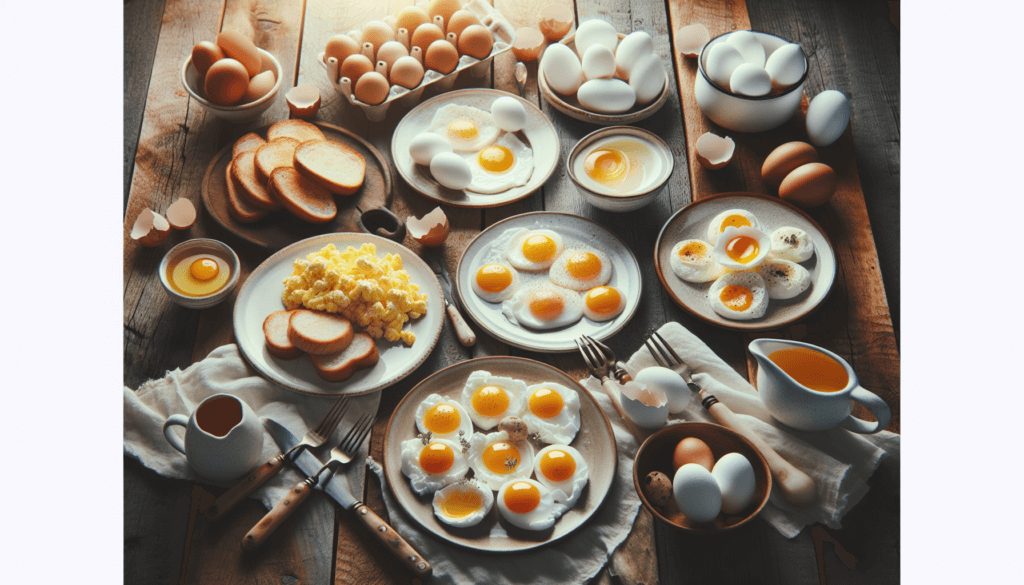If you’re a fan of eggs but find yourself getting tired of the same old scrambled or boiled varieties, then you’re in for a treat. In this article, we’ll explore the best ways to cook eggs and achieve different textures that will elevate your breakfast game. From perfectly creamy poached eggs to crispy fried eggs with a runny yolk, we’ll guide you through step-by-step instructions on how to achieve the egg texture you desire. So get ready to impress your taste buds and become an egg-cooking aficionado in no time!

Soft-Boiled Eggs
Soft-boiled eggs are a classic breakfast staple that many people enjoy. The whites are fully cooked, but the yolk is still runny, making it perfect for dipping toast or soldiers. To make a classic soft-boiled egg, you’ll need to bring a pot of water to a boil and then gently lower your eggs into the water using a slotted spoon. Let the eggs cook for about 6 minutes, and then carefully remove them from the water and place them in an egg cup. Tap the top of the egg with a spoon to crack it open, and you’re ready to enjoy the luscious yolk!
If you prefer your soft-boiled eggs a little more cooked, you can try making six-minute soft-boiled eggs. These eggs have a slightly firmer yolk, but it’s still soft and creamy. To make them, follow the same steps as with the classic version, but cook the eggs for an additional 2 minutes. This will give you a yolk that is fully set on the outside but still slightly runny in the center.
For a variation on the soft-boiled egg, you can try making soft-boiled eggs with a jammy yolk. Jammy eggs have a yolk that is still soft and slightly runny, but instead of being completely liquid, it has a custard-like consistency. To achieve this texture, you can cook the eggs for about 9 to 10 minutes. This will give you a yolk that is set but still creamy in the center. These jammy eggs are a delicious addition to salads or grain bowls.
Hard-Boiled Eggs
Hard-boiled eggs are a versatile ingredient that can be enjoyed in a variety of dishes, from salads to sandwiches. To make a classic hard-boiled egg, you’ll need to place the eggs in a pot of cold water and bring it to a boil. Once the water is boiling, reduce the heat to low and let the eggs simmer for about 9 to 12 minutes, depending on the size of the egg. After the eggs are cooked, transfer them to a bowl of ice water to cool before peeling.
Peeling hard-boiled eggs can sometimes be a challenge, but there are a few tricks you can try to make it easier. One method is to gently tap the egg on a hard surface to crack the shell, and then roll it between your hands to loosen the shell. Another trick is to peel the eggs under running water, as the water can help remove any stubborn shell pieces. It’s also helpful to peel the eggs while they’re still slightly warm, as the shell tends to come off more easily.
Overcooking hard-boiled eggs can result in a dry and rubbery texture, which is not ideal. To avoid this, make sure to follow the recommended cooking time and immediately cool the eggs after cooking. Leaving them in the hot water or allowing them to sit at room temperature for too long can cause them to become overcooked. If you accidentally overcook your eggs, you can still salvage them by using them in dishes like egg salad or deviled eggs, where the texture is less important.

Poached Eggs
Poached eggs have a delicate and silky texture that pairs well with many dishes, such as eggs Benedict or avocado toast. To make a classic poached egg, you’ll need to bring a pot of water to a gentle simmer. Then, create a gentle whirlpool in the water by stirring it with a spoon. Crack the egg into a small bowl and carefully slide it into the center of the whirlpool. Let the egg cook for about 3 to 4 minutes, or until the whites are set but the yolk is still runny. Use a slotted spoon to carefully remove the egg from the water and place it on a paper towel to drain any excess water.
If you prefer your poached eggs with a more set white and a runny yolk, you can try a slightly different method. Instead of creating a whirlpool, you can strain the egg whites through a fine-mesh sieve to remove any loose strands. This will result in a cleaner-looking poached egg with a more defined shape. The cooking time may vary slightly, so it’s best to keep an eye on the eggs and adjust the cooking time to achieve your desired texture.
If you want perfectly shaped poached eggs, you can use a silicone egg poaching cup or a mason jar lid. Simply place the cup or lid in the simmering water and crack the egg directly into it. The cup or lid will help shape the egg as it cooks, giving you a neat and uniform appearance. Once the egg is cooked, gently remove it from the cup or lid and serve.
Scrambled Eggs
Scrambled eggs are a quick and easy breakfast option that can be customized to your liking. To make basic scrambled eggs, start by cracking your eggs into a bowl and whisking them until the yolks and whites are fully combined. Heat a non-stick skillet over medium heat and melt some butter or heat a little oil. Pour the whisked eggs into the skillet and let them cook for a few seconds without stirring. Then, use a spatula to gently scramble the eggs, pushing them from the edges towards the center. Continue cooking, stirring occasionally, until the eggs are just set but still slightly creamy.
For fluffy scrambled eggs, you can add a touch of milk or cream to the whisked eggs before cooking them. This will create a lighter and more airy texture. You can also try separating the whites and yolks and whipping the whites to stiff peaks before folding them back into the whisked yolks. This technique will give you incredibly light and fluffy scrambled eggs.
If you prefer creamy scrambled eggs, you can add a dollop of cream cheese or crème fraiche to the whisked eggs before cooking. This will create a rich and velvety texture. You can also try melting some cheese, like cheddar or Gruyere, into the scrambled eggs for an extra indulgent treat.

Fried Eggs
Fried eggs are a classic breakfast option that can be enjoyed in many different ways. To make sunny-side up eggs, start by heating a non-stick skillet over medium heat and melting some butter or heating a little oil. Crack the eggs into the skillet, season them with salt and pepper, and let them cook for a few minutes until the whites are set but the yolks are still runny. You can cover the skillet with a lid to help cook the yolks without flipping the eggs.
If you prefer your fried eggs with a slightly cooked yolk, you can try making over easy or over medium eggs. To make over easy eggs, start by cooking the eggs sunny-side up as described above. Once the whites are set, carefully flip the eggs using a spatula and cook for an additional minute or two, until the yolks are still slightly runny. For over medium eggs, cook the eggs sunny-side up and then flip them when the whites are set. Cook for an additional 2 to 3 minutes, until the yolks are more set but still slightly soft in the center.
If you like your fried eggs with a fully cooked yolk, you can make over hard eggs. Simply cook the eggs sunny-side up and then flip them when the whites are set. Cook for an additional 4 to 5 minutes, until the yolks are fully cooked and no longer runny. These eggs are perfect for those who prefer a more solid yolk.
Omelettes
Omelettes are a versatile dish that can be filled with a variety of ingredients, making them a great choice for any meal of the day. To make a classic French omelette, start by beating a couple of eggs in a bowl until the yolks and whites are fully combined. Heat a non-stick skillet over medium heat and melt some butter. Pour the beaten eggs into the skillet and let them cook for a few seconds without stirring. Use a spatula to gently lift and fold the edges of the omelette towards the center, allowing the uncooked eggs to flow to the edges. Continue cooking, gently lifting and folding, until the omelette is cooked but still slightly creamy in the center. Fold the omelette in half and serve.
For a cheesy omelette, you can add your favorite cheese, such as cheddar, feta, or Swiss, to the beaten eggs before cooking. Sprinkle the cheese evenly over the eggs and mix gently before pouring them into the skillet. As the omelette cooks, the cheese will melt and create a deliciously gooey filling.
If you prefer a vegetable omelette, you can sauté some chopped vegetables, such as bell peppers, onions, and mushrooms, before adding them to the beaten eggs. Cook the vegetables in a little bit of oil or butter until they are soft and slightly caramelized. Then, mix them into the beaten eggs and pour the mixture into the skillet. Cook as you would for a classic omelette, folding the edges and cooking until set.
For a protein-packed omelette, you can add cooked bacon, ham, or sausage to the beaten eggs before cooking. You can also add some diced cooked chicken or turkey for a leaner option. The additional protein will make the omelette more filling and satisfying.

Baked Eggs
Baked eggs are a delicious and low-maintenance way to cook eggs. They can be made with a variety of flavorful ingredients and are great for feeding a crowd. To make baked eggs with herbs, start by preheating your oven to 375°F (190°C). Grease a small baking dish or ramekin with butter or oil. Crack the eggs into the dish, being careful not to break the yolks. Sprinkle the eggs with your favorite herbs, such as chives, parsley, or thyme. Season with salt and pepper, and then bake for about 8 to 10 minutes, or until the whites are set but the yolks are still slightly runny.
For baked eggs with cheese, follow the same steps as above, but sprinkle grated cheese over the eggs before baking. You can use any type of cheese you like, such as cheddar, mozzarella, or feta. As the eggs bake, the cheese will melt and create a gooey and flavorful topping.
To make baked eggs with spinach, start by wilting some fresh spinach leaves in a skillet with a little bit of oil or butter. Once the spinach has wilted, transfer it to a greased baking dish or ramekin and crack the eggs over the top. Season with salt, pepper, and any other desired spices. Bake the eggs for about 10 to 12 minutes, or until the whites are set and the yolks are still slightly runny. The combination of the savory spinach and the creamy yolks is simply delicious.
For a unique and nutritious twist, you can make baked eggs in an avocado. Cut an avocado in half and remove the pit. Scoop out a little bit of the flesh from each half to create enough space for the eggs. Crack an egg into each avocado half and sprinkle with salt, pepper, and any desired spices. Place the avocado halves in a baking dish and bake for about 12 to 15 minutes, or until the eggs are cooked to your liking. The creamy avocado pairs perfectly with the baked eggs, creating a healthy and satisfying dish.
Eggs Benedict
Eggs Benedict is a classic brunch dish that consists of a toasted English muffin topped with a poached egg and hollandaise sauce. To make a traditional eggs Benedict, start by toasting an English muffin until golden brown. Next, make a poached egg using the method described earlier. Place the poached egg on top of the toasted muffin. Finally, drizzle hollandaise sauce over the egg and serve immediately. The combination of the runny yolk, the creamy hollandaise sauce, and the toasty English muffin is absolute perfection.
For a fun twist on the traditional eggs Benedict, you can try some variations. One popular variation is the Florentine eggs Benedict, which substitutes the Canadian bacon with sautéed spinach. Simply cook the spinach in a skillet with a little bit of garlic and olive oil until wilted, and then place it on top of the toasted English muffin before adding the poached egg and hollandaise sauce.
Another delicious variation is the smoked salmon eggs Benedict. Instead of Canadian bacon, use thinly sliced smoked salmon as the base for the poached egg. The salty and smoky flavor of the salmon pairs beautifully with the rich hollandaise sauce.
For a vegetarian option, you can make a mushroom eggs Benedict. Sauté some sliced mushrooms in a skillet with a little bit of butter until they are golden brown and tender. Place the mushrooms on top of the toasted English muffin and layer the poached egg and hollandaise sauce on top.
The variations for eggs Benedict are practically endless, allowing you to customize the dish to your taste and dietary preferences.

Egg Salad
Egg salad is a classic dish that is perfect for picnics, lunches, or an easy dinner. To make a classic egg salad, start by hard-boiling a few eggs. Once the eggs are cooked and cooled, peel them and chop them into small pieces. In a bowl, combine the chopped eggs with mayonnaise, mustard, and a pinch of salt and pepper. Mix everything together until well combined. You can also add some chopped celery or green onions for added crunch and flavor. Serve the egg salad on a bed of lettuce, in a sandwich, or with crackers for a delicious and satisfying meal.
For a healthier twist on egg salad, you can try making a healthy avocado egg salad. In this version, the mayonnaise is replaced with ripe mashed avocado, which adds creaminess and a boost of nutrients. Simply mash a ripe avocado in a bowl and mix it with the chopped hard-boiled eggs. Add a squeeze of lemon juice, salt, and pepper to taste. You can also add some diced tomatoes, cucumber, or red onion for extra freshness and texture.
If you’re looking for a more flavorful and spicy egg salad, you can try making a curried egg salad. In this version, the chopped hard-boiled eggs are mixed with mayonnaise, curry powder, ground cumin, and a pinch of cayenne pepper. You can also add some raisins, chopped apple, or diced red bell pepper for added sweetness and crunch. The curry flavors add a delicious and aromatic twist to the traditional egg salad.
For a heartier egg salad, you can make a bacon and egg salad. Cook some bacon until crispy and chop it into small pieces. In a bowl, combine the chopped hard-boiled eggs with mayonnaise, Dijon mustard, and the chopped bacon. You can also add some diced tomatoes, chopped lettuce, or crumbled feta cheese for added flavor and texture. This bacon and egg salad is a satisfying and indulgent option that is perfect for a filling lunch or dinner.
Egg Sandwiches
Egg sandwiches are a quick and tasty option for breakfast, lunch, or a snack on the go. To make a classic egg sandwich, start by frying or scrambling an egg to your liking. If frying the egg, you can make it sunny-side up, over easy, over medium, or over hard, depending on your preference. Once the egg is cooked, place it on a slice of toasted bread and season it with salt and pepper. You can also add some cheese, like cheddar or Swiss, for an extra layer of flavor. Top the egg with another slice of toasted bread, and your classic egg sandwich is ready to enjoy.
For a heartier option, you can make an egg and bacon sandwich. Cook some bacon until crispy and drain it on a paper towel. Fry or scramble an egg, and then assemble the sandwich by placing the cooked bacon on top of the egg. You can also add some lettuce, tomato slices, or avocado for added freshness and crunch. The combination of the smoky bacon, the savory egg, and the tangy mayo is simply mouthwatering.
If you’re vegetarian or looking for a meat-free option, you can make a vegetarian egg sandwich. Add some sautéed mushrooms, bell peppers, and onions to a skillet with a little oil or butter. Season with salt and pepper, and cook until the vegetables are tender and slightly caramelized. Fry or scramble an egg, and then assemble the sandwich by placing the cooked vegetables on top of the egg. You can also add some spinach, sliced tomatoes, or a dollop of hummus for added flavor and nutrition.
For a spicy kick, you can make a spicy egg sandwich. Mix some Sriracha or your favorite hot sauce with mayonnaise to create a spicy mayo. Fry or scramble an egg, and then spread the spicy mayo on a slice of toasted bread. Place the cooked egg on top, and sprinkle with sliced jalapeños or chili flakes for added heat. The spicy mayo adds a delicious punch and elevates the simple egg sandwich to a whole new level.
In conclusion, eggs are a versatile and delicious ingredient that can be cooked in a variety of ways to achieve different textures. Whether you prefer them soft-boiled, hard-boiled, poached, scrambled, fried, baked, or used in various dishes like eggs Benedict, egg salad, or egg sandwiches, there are endless possibilities to explore. So next time you’re in the mood for eggs, feel free to experiment with different cooking methods and ingredients to find your perfect texture and flavor combination. Enjoy your eggy culinary adventures!


